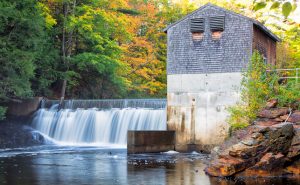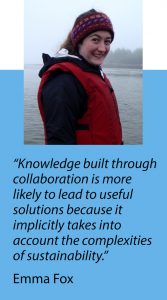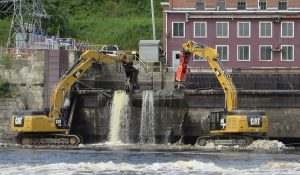Learning from Dams
An innovative multi-institution course teaches the fundamentals of sustainability science

The Mitchell Center’s Future of Dams project is designed to develop a stakeholder-engaged, solutions-focused framework for decision-making relative to New England’s hydropower dams—more than 50 of which are scheduled for relicensing in the next decade—and iconic mill dams, many of which are now falling into disrepair.
The project aims to help communities and decision-makers make more evidence-based, cost-effective, and culturally sensitive decisions about the future of dams. For example, maintaining or expanding existing hydropower dams, removing old, obsolete dams to reduce safety risks, or building fish passage to restore natural habitat for our valuable fisheries.
Using a variety of innovative teaching methods and video conferencing technologies, the inaugural course, “Learning From Dams: Theory and practice of sustainability science,” put graduate and undergraduate students from a host of different disciplines and institutions, including UMaine, the University of New Hampshire, University of Rhode Island and University of Southern Maine, into the thick of that complex decision-making process.
And more often than not, the course put the students in the driver’s seat as things rolled along—including a portion that included role play as stakeholders and meetings with dam stakeholders themselves. These included three town planners, one resident, and the New Hampshire dam removal coordinator.
 The course was designed to: introduce and build capacity for the growing field of sustainability science; provide an opportunity for students to learn more about each other’s research interests and disciplinary training; help students understand how science can contribute more effectively to solving societal problems; and prepare students to fill diverse leadership roles in addressing complex challenges that require a balance between economic development and environmental protection.
The course was designed to: introduce and build capacity for the growing field of sustainability science; provide an opportunity for students to learn more about each other’s research interests and disciplinary training; help students understand how science can contribute more effectively to solving societal problems; and prepare students to fill diverse leadership roles in addressing complex challenges that require a balance between economic development and environmental protection.
Mitchell Center postdoctoral researcher Sam Roy is a team member of the Future of Dams project, which is part of the New England Sustainability Consortium (NEST) regional research partnership, and a co-instructor of the course.
“Perhaps the biggest take away we’ve seen is students now have greater confidence in forging collaborations and producing interdisciplinary work,” says Roy. He adds, “And they are also thinking more strategically about sustainability science—how best to break down a problem to better understand its causes, who or what it impacts, and how to craft potential solutions.”
The 24 students started scoping collaborative science early in the course by giving two-minute elevator speeches to the class that described who they are, what they are interested in studying regarding dams and sustainability, and ideas for collaborating with others. Then, after some meetings in which students learned about each other’s expertise, “We had them come up with proposals where students from different fields work together: engineering and fisheries students studied turbine shutdown as a means of improving fish passage; an economics major worked with a student interested in stream restoration to determine why communities become attached to their dams; and students interested in sociology and computer science worked together to create exercises where stakeholders can explore future scenarios. So that cross fertilization emerged from the students themselves,” notes Roy.

Ph.D. student Tyler Quiring of the UMaine Department of Communication and Journalism and Future of Dams team member took the course in part to advance research he’s been doing designing websites for collaborators on another NEST project, Safe Beaches & Shellfish. Specifically, Quiring forged a number of potential collaborations with classmates that will provide “seed” material for an ongoing blog dedicated to the Future of Dams project, a blog that will become a multi-disciplinary, living document that will continually build the team’s knowledge base.
“It’s no longer possible to work on these big complex problems in single disciplines or even by different disciplines just talking to each other,” says Quiring. “And I think this is one of the major foci of the Future of Dams project—bringing together the work of those disciplines at every level.”
Adds UMaine Ph.D. student Emma Fox, who is also a Future of Dams team member and course participant, “Knowledge built through collaboration is more likely to lead to useful solutions because it implicitly takes into account the complexities of sustainability. When you draw from multiple disciplines you build a more diverse and extensive toolset, with an awareness of the need to balance competing or complementary objectives, values, and strategies for reaching sustainable solutions.”
